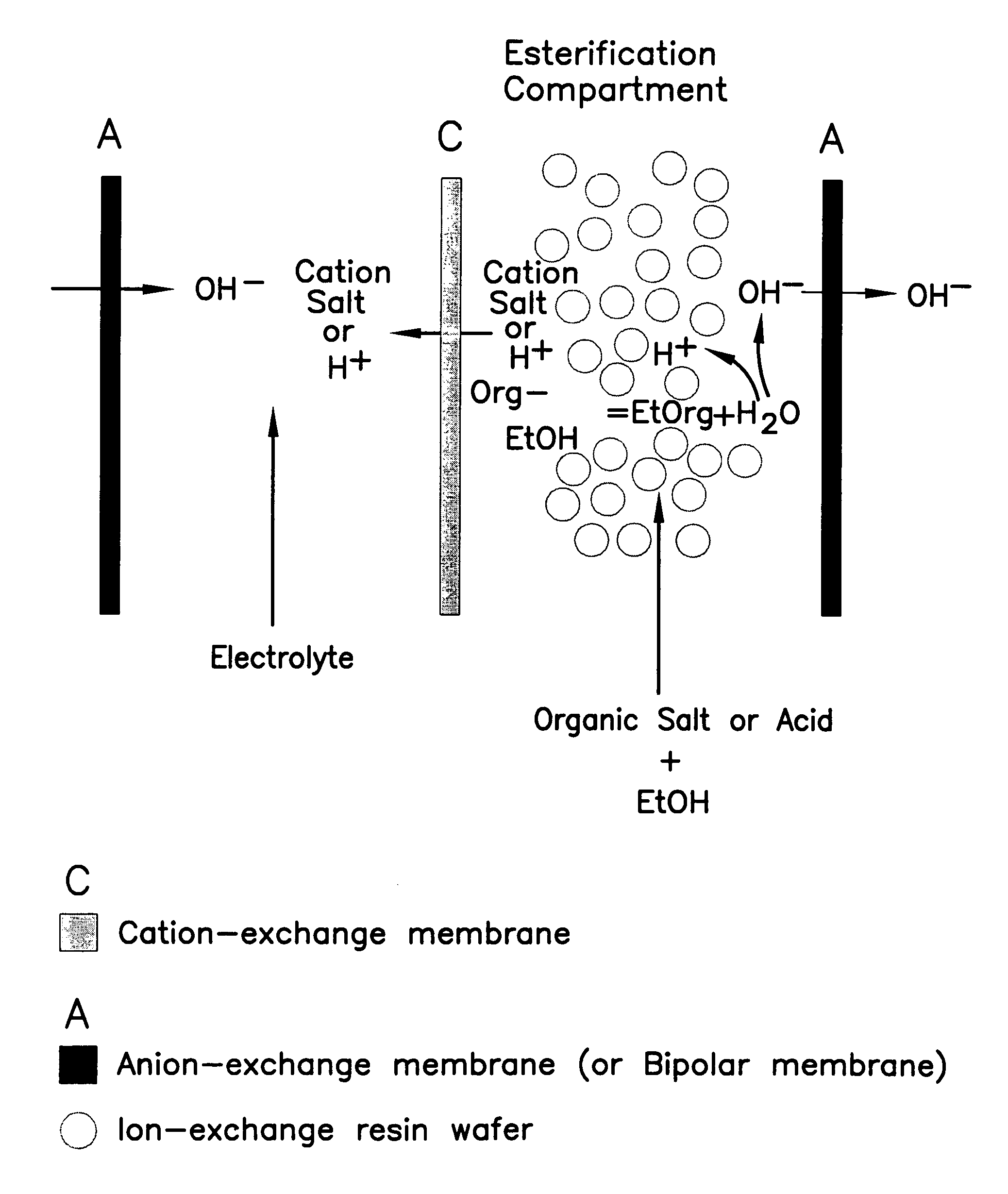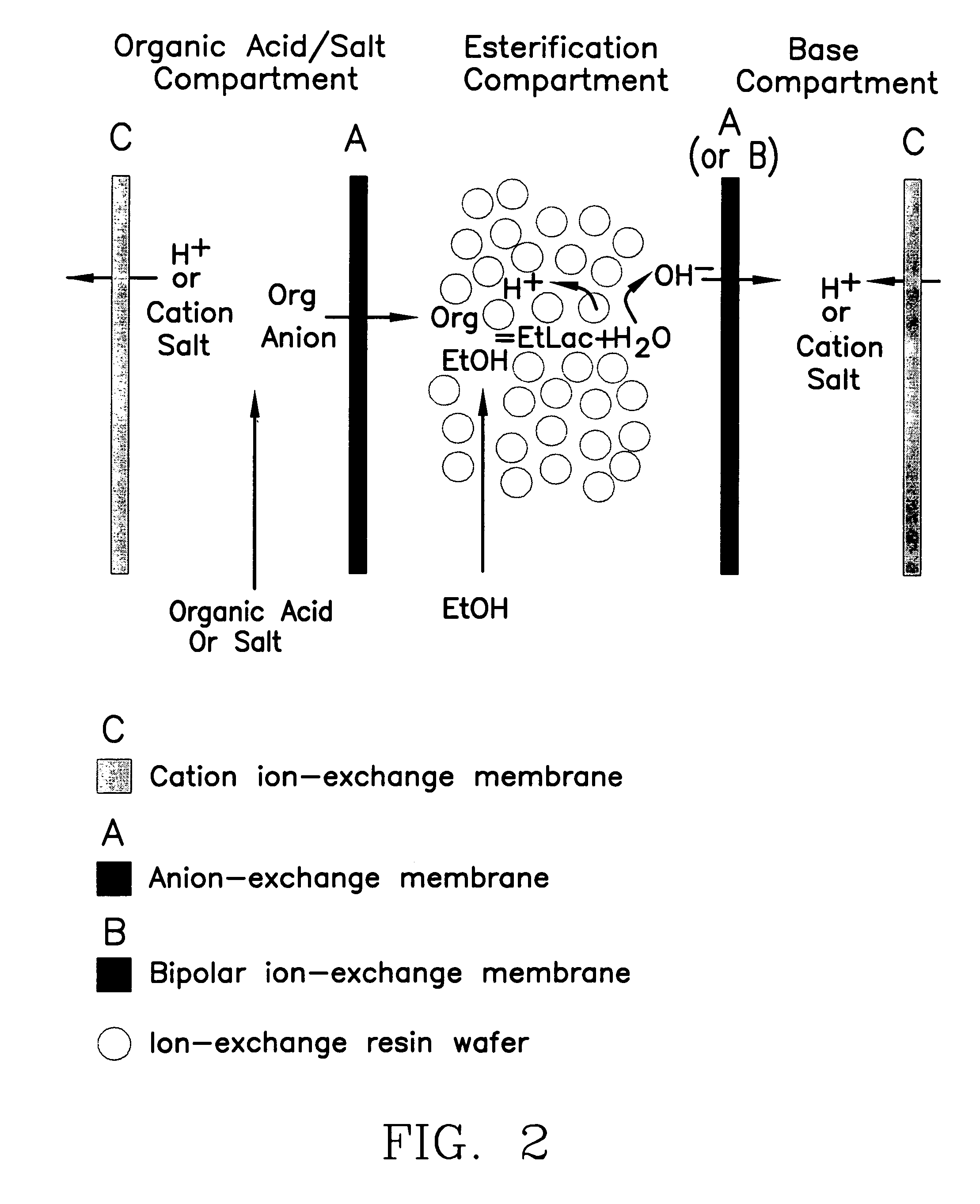Single-stage separation and esterification of cation salt carboxylates using electrodeionization
a technology of cation salt carboxylate and electrodeionization, which is applied in the direction of fluid pressure measurement, liquid/fluent solid measurement, peptide measurement, etc., can solve the problems of high cost of conversion and subsequent acid recovery, waste calcium sulfate production, and limited commercial application
- Summary
- Abstract
- Description
- Claims
- Application Information
AI Technical Summary
Benefits of technology
Problems solved by technology
Method used
Image
Examples
example 1
[0027]Three experiments are carried out to demonstrate the single-stage catalytic reactor of the esterification process, see FIG. 1. In the first two experiments, 1.35 mole percent of lactic acid or 0.83 mole percent of sodium lactate in ethanol with 2.5 g of cation-exchange resin ®DOWEX DR2030 (from Dow Chemical Inc.) are placed into two reactors respectively. The third experiment uses a reactor containing 1.35 mole percent of lactic acid in ethanol without the presence of a cation-exchange resin. The initial water content in the reactors is in the range of 3.5–3.6 mole percent. All the reactors are operated at 50° C. FIG. 5 shows the conversion of lactate to ester. Sodium lactate has a greater rate of conversion to the ester as compared with lactic acid in alcohol during the same period of operation. Sodium lactate which is more easily ionized to lactate ion shows more favorable esterification. The more limited amount of ionic lactate with the lactic acid solution appears to limit...
example 2
[0029]Similar to the configuration showed in FIG. 2, a “three-compartment” EDI stack used to produce the ethyl lactate. An ED stack (Tokuyama Inc., model TS-2) filled with an immobilized resin wafer containing ®C100E (cation resin bead) and ®A444 (anion resin bead) ion-exchange resins (from Purolite Company) was used as the EDI device. ®AMH (anion permeable) and ®C6610F (cation permeable) ion exchange membranes (from Tokuyama Inc.) were used in the stack. The membrane surface area was 195 cm2. A feed of 10% sodium lactate was re-circulated in the feed compartment (i.e., compartment 1 in FIG. 2). Pure ethanol was fed into the product compartment (compartment 2). Sodium hydroxide was recovered from the base compartment (compartment 3). The operating temperature was maintained around 35° C. FIG. 6 shows the production of ester obtained in the production compartment using this EDI stack. 4–6 wt. % of water was found in the product compartment which we attributed to diffusion through the...
example 3
[0030]The same EDI stack as described in Example 2 was used, see FIG. 4. The ion-exchange membranes used in the stack were a bipolar membrane (®BP-1) and anion-exchange membrane (AMH) purchased from Tokuyama Inc. 1% sodium lactate was used to simulate the organic acid production in the substrate compartment. Pure ethanol was used in the esterification compartment. The operation temperature was maintained at 30° C. FIG. 7 shows the ester production and water content in the product. The high water content diffused from the substrate compartment eventually re-hydrated the ester after 1400 minutes operation.
PUM
| Property | Measurement | Unit |
|---|---|---|
| porosity | aaaaa | aaaaa |
| porosity | aaaaa | aaaaa |
| surface area | aaaaa | aaaaa |
Abstract
Description
Claims
Application Information
 Login to View More
Login to View More - R&D
- Intellectual Property
- Life Sciences
- Materials
- Tech Scout
- Unparalleled Data Quality
- Higher Quality Content
- 60% Fewer Hallucinations
Browse by: Latest US Patents, China's latest patents, Technical Efficacy Thesaurus, Application Domain, Technology Topic, Popular Technical Reports.
© 2025 PatSnap. All rights reserved.Legal|Privacy policy|Modern Slavery Act Transparency Statement|Sitemap|About US| Contact US: help@patsnap.com



